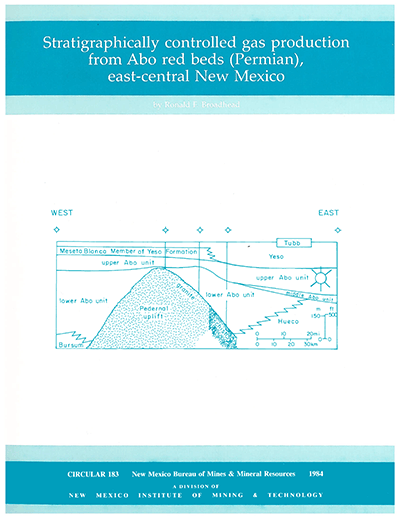
Circular 183—Stratigraphically controlled gas production from Abo Red Beds (Permian), east-central New Mexico
By R. F. Broadhead, 1984, 36 pp., 5 tables, 26 figs., 3 appendices.

The Abo red beds in the subsurface of Chaves County have become some of the most important targets of natural gas drilling since they were designated "tight gas sand" in 1980. In this report, the Abo red beds of east-central New Mexico have been mapped and analyzed geologically with emphasis on the lithologic characteristics of productive Abo sandstones. Red-bed sandstones of the Abo Formation currently produce natural gas from the Pecos Slope Abo field in northern Chaves County, New Mexico. The productive area of the field currently covers approximately 700 mi2.
First production from the Abo red-bed facies was obtained in 1977 by the Yates Petroleum Corp. No 1 McConkey located in sec. 10, T. 9 S., R. 26 E., Chaves County. The Yates well was a workover of the Honolulu Oil Corp. No. 1 McConkey Estate, originally abandoned as a dry hole in 1951. Yates tested the Ellenburger Group and the Devonian and Pennsylvanian Systems without success. The Abo red beds were then tested to verify gas detected by crossover of the neutron-porosity and density-porosity logs. After acidization and artificial fracturing were done, an 18 ft thick sandstone bed in the Abo produced 2,550 MCFGPD and 1 BCPD. The discovery prompted operators to drill a few more wells in the area to specifically test the red beds. These additional wells confirmed the discovery. Drilling continued at a slow pace until 1980. In that year, the Abo red beds were designated a "tight gas sand" by the Federal Energy regulatory Commission. That designation raised the ceiling price at which production could sell gas from $2.81 to $4.92 per thousand ft3 of gas. The ceiling price has subsequently been raised to $5.41 per MCF. At these higher prices, gas can be produced economically from the tight Abo sandstones. Since the tight-sand designation, more than 350 gas wells have been drilled and completed in the Abo red beds.
Red-bed sandstones of the Abo Formation currently produce natural gas from
the Pecos Slope Abo field in northern Chaves County, New Mexico. The Pecos
Slope Abo field is located on the northwest shelf of the Permian Basin.
Production currently comes from an approximately 700 mi2 area. The Abo
red beds are subdivided vertically into three informal lithologic units
on the northwest shelf of the Permian Basin: a lower unit of "granite
wash," a middle unit of mudstone, an upper unit of interbedded sandstone
and mudstone. The lower unit of "granite wash" is more than 800
ft thick in some places and is composed of interbedded, coarse-grained arkosic
sandstone s and arkosic conglomerates. This unit rings Abo-age uplifts
of Precambrian granitic basement and intertongues basinward with marine
limestones of the Hueco Formation. The middle unit is approximately 100
ft thick and conformably overlies the clastic facies of the lower unit of
the Hueco limestone facies. The middle unit is composed of calcareous, sparsely
fossiliferous, argillaceous mudstone and minor fine-grained sandstone. It
is a shallow-marine shelf deposit. The upper unit is approximately 600 ft
thick and is composed of interbedded mudstones and lenticular sandstones.
It conformably overlies the middle unit and is disconformably overlain by
the dolostones, anhydrites, and fine-grained sandstones of the Yeso Formation.
The upper unit intertongues southward with lagoonal dolostones; a shelf-margin
reef facies lies south of the lagoonal dolostones. Sandstone lenses are
generally 10 ft to 20 ft thick. Sandstones are very fine grained, arkosic,
and hematitic. The upper unit was deposited as a fluvial-deltaic system
which prograded southward over the marine mudstones of the middle unit.
Gas is produced from the sandstones of the upper unit. Primary porosity
has been reduced by compaction to values near zero and is present mostly
as submicroscopic pores. The average in situ permeability of Abo sandstones
is only 0.0067 millidarcies. Such small amounts of matrix porosity and permeability
probably do not contribute greatly to production. The Abo wells tap a gas-filled
natural fracture system, and mudstones seal the fractured sandstone reservoirs.
Because fluvial-deltaic deposits extend almost 100 mi north of present production,
the area underlain by potential Abo sandstone reservoirs is at least five
times greater than the area is currently productive.
$8.00
Buy
Now
Also available as a free download.
Download
| File Name | Size | Last Modified |
|---|---|---|
| Circular-183-appendices.pdf | 4.16 MB | 01/11/2021 03:41:53 PM |
| Circular-183.pdf | 33.63 MB | 01/11/2021 03:41:38 PM |



